First thought had been along the lines of squash the pipe alternately at 90 degrees with pliers. Then a
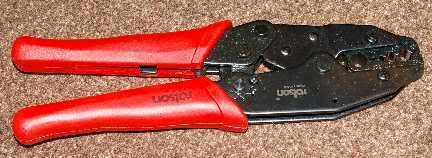
There are different sizes of hexagonal dies for doing the various plug-and-cable combinations. You put the ferrule on the cable, prepare the end of the cable and crimp the centre pin, then slide the ferrule over the end and go crunch. There is a ratchet which lets go when it's tight enough.

I tried it out on a stub of 8mm copper tube, and the next-to-largest one crimps slight dents in the tube.
OK, time for a comparison of plain tube and crimped tube. I made two more-or-less identical U-shapes in 8mm copper, with a right-angled bend at the bottom, as sort-of miniature ICs. One of them I crimped about every centimetre:
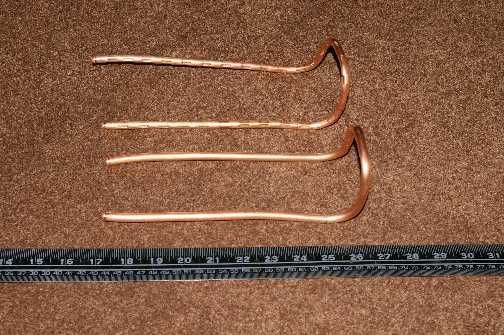
Here is a close-up:

Here is the plain loop end:
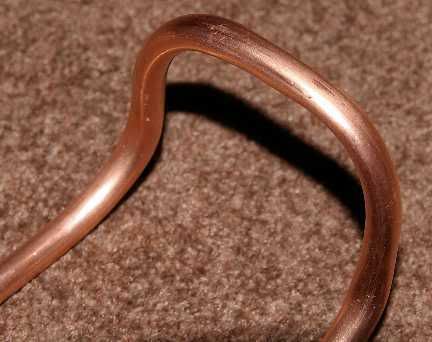
and here is the crimped loop:
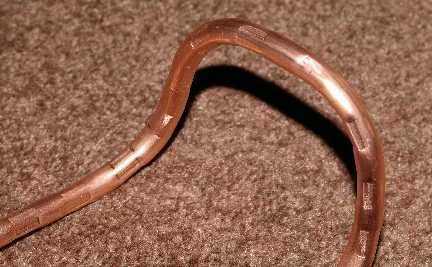
Would the dents be enough to stop the flow of water being entirely laminar and inefficient?
Test rig:
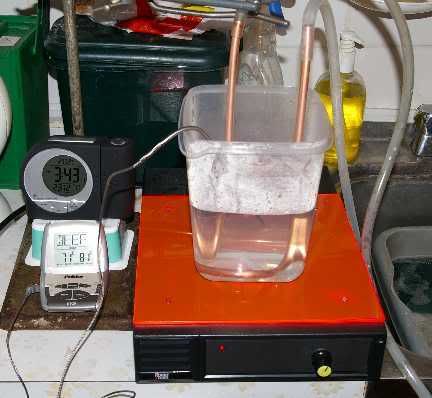
Plastic box on stir plate, cooking thermometer, cold water from tap through mini IC. I boiled some water in the kettle, poured 1 litre into a measuring jug, and poured that into the plastic box while trying to start the magnetic stirrer. The TC department, who used to work in a lab, assures me that even the proper ones can be a pain to get going without the stir bar spinning off into next week. Once the thermometer has stopped changing rapidly (equilibrium, sort-of), I turned the cold water on. The IC had been empty up to that point.
Here the flash has stopped the stir bar - it must have been whizzing round as you can see the vortex in the water:

By the time I'd got the kettle water into the box the temperature had dropped to 80-odd dregrees. The measurements aren't very accurate - I should have used a stopwatch rather than taking pictures of the alarm clock
Sorry about the formatting - I don't know how to do a table in PHP.
tap water at 9C
time temp degree C temp drop time taken
1st run plain tube
15:43:11 81
15:51:16 24 57 00:08:05
1st run convoluted tube
16:00:00 83
abandoned because cold water trickling out of one of the hoses and filling up the plastic box
2nd run convoluted tube
16:17:41 83
16:23:59 24 59 00:06:18
2nd run plain tube
16:33:12 82
16:41:26 24 58 00:08:14
3rd run convoluted tube
17:20:32 83
17:27:03 24 59 00:06:31
Average time for the plain tube = 8'09", average for the convoluted tube = 6'25" to bring the water down about 58 degrees. The convoluted tube, with slight crimps every centimetre, seems to be slightly more efficient.
What if we had serious dents in the tube? I took the one with the dents every centimetre, and put another crimp in between each of the existing ones, this time using a smaller size of die on the crimping tool:
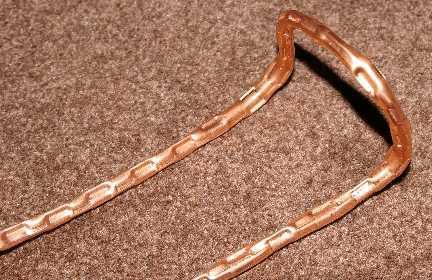
This made it a little bit faster, but not very much more:
1st run very convoluted
18:02:25 81
18:09:07 24 57 00:06:42
2nd run very convoluted
18:17:10 86
18:22:37 24 62 00:05:27
Average of two 6'04" to cool the water by 59 degrees.
These figures aren't reliable enough. I suppose If I'd started earlier and done ten goes with each test loop it might be better, but I'd still be at it!
I have to make a new, bigger IC for my new shiny HLT/boiler (post follows sometime), so I might spend a happy couple of days crimping copper coils

